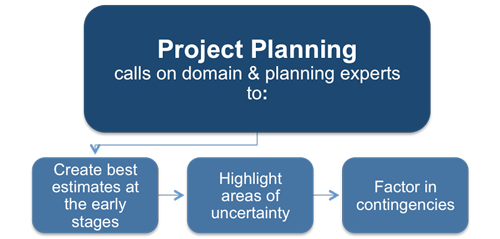Rolling Wave Planning
Rolling Wave Planning (RWP) is the process of planning in waves as the project proceeds and later details become clearer. It involves progressive elaboration and is based on the fact that activities required in the immediate future will be known in greater detail than those further into the future.
Progressive Elaboration means that the work packages are refined in greater detail over time. RWP is particularly useful in projects of high uncertainty like software development or R&D projects, where the project goal is known, but the final deliverable may change somewhat as the project progresses.
 |
Attempting to create detailed task-oriented plans for project teams in these types of environments is likely to lead to plans that are abandoned soon after being published and a great deal of project management time spent endlessly re-planning rather than actually managing the project.
Rolling wave planning is more often used within IT type projects but less so within the construction industry where lack of detail in initial plans may cause huge expense later. Unfortunately many IT projects undertake the bulk of their planning too early in the lifecycle, when little concrete data is known about the problem domain, business environment, or how the team will work together. Rolling wave planning is rarely used in the construction industry, where lack of detail in initial plans may cause huge expense later.
 |
Even though a complete set of plans cannot usually be developed ahead of the formal start of the project, high-level plans do need to be produced to define the overall size, cost, and duration. These are necessary in order to seek the formal approval required for their initiation. This raises the question, 'How can projects be quantified and approved ahead of a detailed understanding of the resource and cost implications?'
This question has no simple answer. However, the planning process should call upon both planning and domain experts in defining the overall size and cost of the project. It should be recognized that best estimates often have to be used in the early stages of planning, but that areas of uncertainty should not be 'glossed over.' In fact, these areas should be highlighted, so that contingencies can be factored in and the planning of these areas can be refined at a later date.
Some of the decisions that will need to be made include:
• How detailed to make the plan
• How far ahead to plan
• How to involve stakeholders in planning
• How to keep the planning process streamlined
• How to manage the data that is being fed back into the planning process
• How to determine the quality and reliability of this information
• How often to re-plan
• How to administer changes to the plan
• How to minimize the effect of changes on work in progress
This is an approach that iteratively plans for a project as it unfolds, similar to the techniques used in Scrum (development) and other forms of Agile software development. The concepts of rolling wave planning and progressive elaboration are common to many project management methods.


